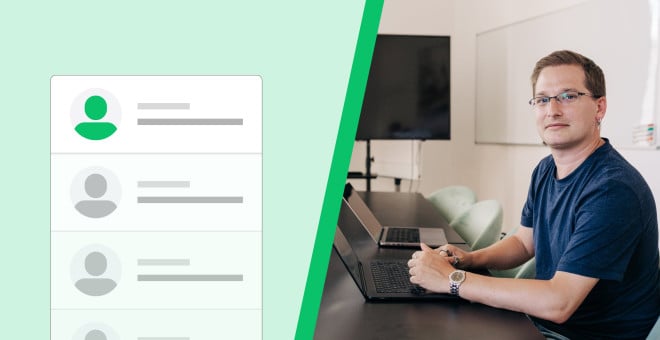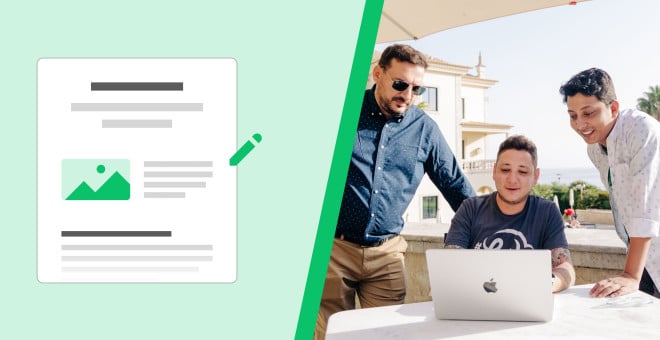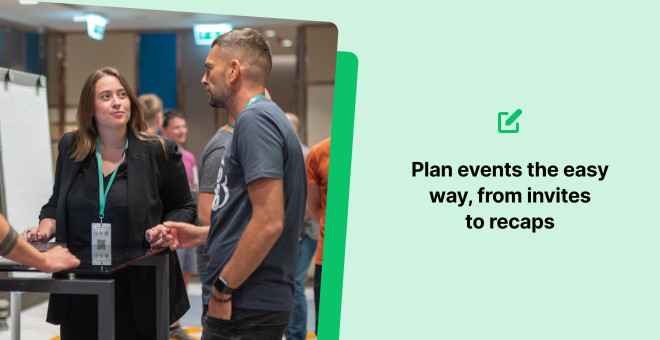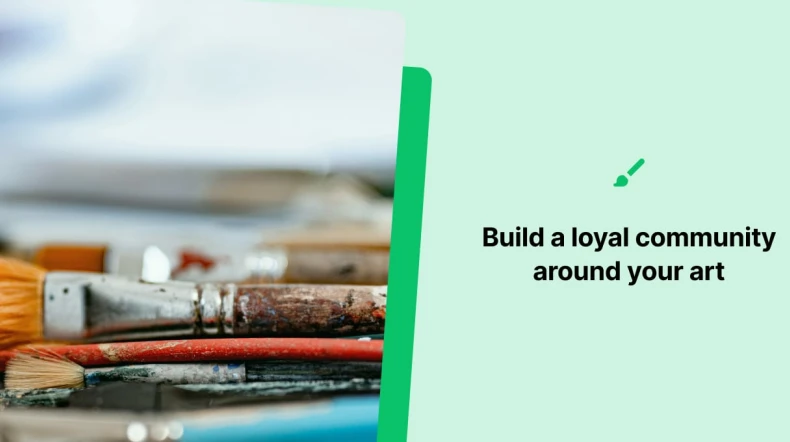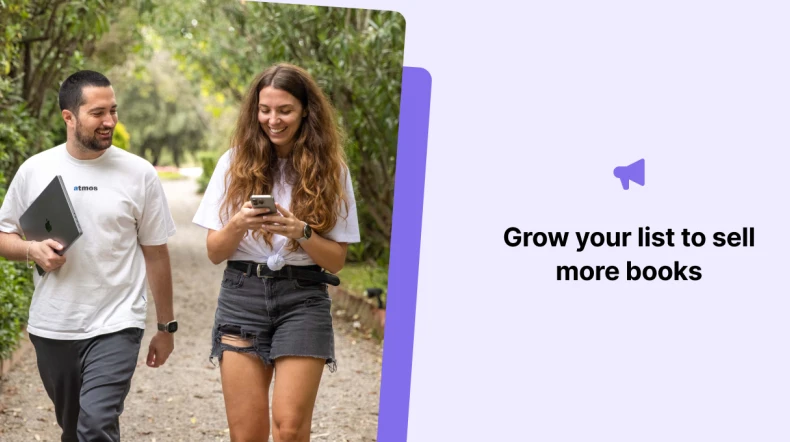Email marketing for artists and art galleries
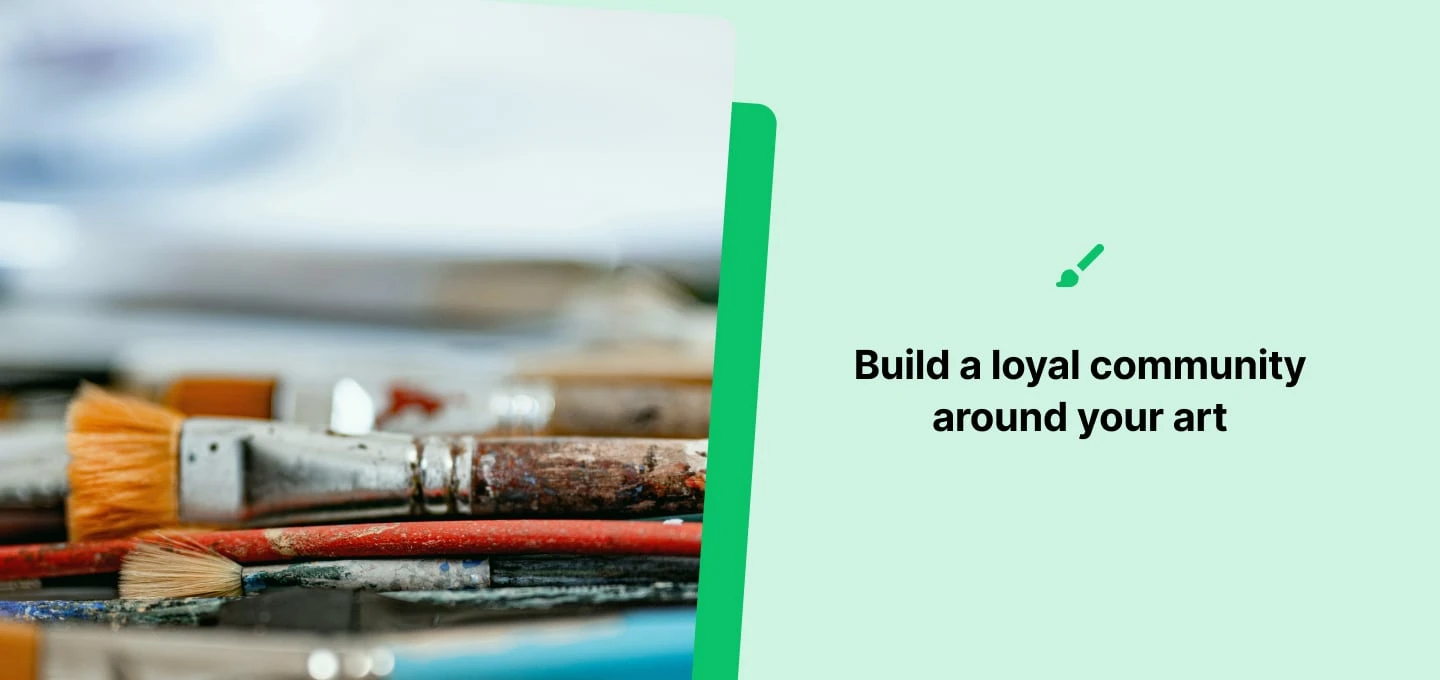
Social media may be the best way for artists to showcase their art. But to turn passive viewers into long-lasting customers, you need to build personal connections. Enter email marketing.
Email marketing gives artists like you a platform for communicating directly with your target audience on a personal level. Once people sign up for your email list, it’s up to you how you want to develop the relationship further. You control the conversation.
You can get one-time buyers to become repeat customers and converse with people who showed interest in your work but weren't ready to buy at the time.
Read on to learn why email marketing is the best channel to nurture relationships and sell art. We’ll show you how to build your email list and what email marketing campaigns to send. We'll also share some email marketing tips and inspire you with great examples!
Benefits of email marketing for artists
Creating a buzz for yourself in the art world and getting your work out there is super hard! Many artists try their digital luck by creating a website and claiming their handle on diverse social media platforms.
But email marketing undoubtedly remains the champion because for every dollar spent on email marketing, the returns could be anywhere between $36 to $45. That’s an incredible 3,600% to 4,500% return on investment!
Here are specific reasons why email marketing is the best digital channel for artists and galleries:
Own your audience: Unlike social media, where you rely on unpredictable algorithms, your email list is a safe place you control
Talk directly to your subscribers: Gaining an email subscriber means you can connect with them directly, ensuring your message always gets delivered
Impressive engagement rates: Email open rates for artists and galleries are over 50% and click rates are over 3%, with very low unsubscribe rates (less than 0.2%). This means a significant portion of your audience is actively engaging with your content
You could collect email addresses in a variety of ways. However, for a truly professional and efficient approach, a dedicated email marketing platform is essential. Here's why:
Minimal manual work: Email subscribers are automatically added and removed (when they unsubscribe) from your list
Target groups: By segmenting email subscribers, you can send personalized emails that resonate with different groups (from art fans to magazine editors)
Email templates: With predefined templates, you can easily add text, images and videos of your art and send beautiful, professional newsletters
Real-time reports: After hitting send, you can see popular stats such as who opened, clicked or bought something from your email.
How to get started with email marketing as an artist
From defining the ideal target audience to collecting your first email subscribers—let’s discover the 3 steps to building your email list as an artist.
1. Define your scope
As an artist, whimsy is a beautiful trait to have. But when it comes to email marketing, you need a bit of planning to make sure you reach the right people at the right time.
Start with brainstorming the scope of your emails with questions like:
What kind of emails do you want to send?
How frequently do you want to send campaigns?
Are you primarily selling art, sharing insights, or promoting events?
Having a clear vision for your email content will make it easier to plan and attract the right kind of subscribers who like your work, want to hear from you, and are interested in what you have to offer.
As an artist, your emails can focus on areas like:
Behind-the-scenes glimpses of your creative process
Announcements of new artwork releases (for sale or exhibition)
Personal stories that connect readers to your work
If you are an art gallery, your scope might involve:
Sharing curated exhibition details
Artist spotlights
Invitations to exclusive events
Updates on new acquisitions
Your email sending frequency might be once, twice, or thrice a month, aligning with your painting schedule or exhibition calendar. MailerLite’s analysis of over 1 million campaigns sent from its platform in 2024 shows that 69% MailerLite users send at least one email a month, while 54% send at least once a week. Sending anywhere between 1 and 3 emails a month is the most common cadence we observed.
2. Define the ideal audience for your email marketing list
When building your email list, you want to target the right audience so you can focus on conversations with interested fans, valuable connections and potential prospects.
For an artist or art business, your email list audiences could be:
Family and friends
Business contacts
Fans and frequent visitors
Clients and future clients or prospects
Art dealers, designers, artists and other art professionals
Influencers in the art scene, including bloggers and critics
(Local) news and magazine editors
Once you have a clear picture of who you're trying to reach, the next step is to start collecting their email addresses.
Collect subscribers online via web and social media
The easiest way to grow your email list as an artist is to focus on everyday interactions such as inquiries on your website, messages on social media, email and phone calls.
To collect subscribers, add email signup forms on different pages of your website or add a link in your email signature. When fans opt in to your mailing list, they’re giving you a direct line to communicate with them, so give them every opportunity to do so.
If you want to learn more, we explain how to grow a high-quality email list for your art business in this in-depth guide.
Social media is also a fantastic way to grow your email list. You can direct people to your website and get them to sign up through pop-ups and embedded forms, or create an opt-in landing page and simply add the link to your profiles on Facebook, Instagram, or TikTok.
Platforms like Facebook and Instagram are excellent for discovery. Use social media to share valuable content, host events, or run contests that encourage your followers to subscribe.
You could also use your existing email list to create a lookalike audience on Facebook. This allows you to find new potential subscribers who have similar interests and demographics to your most engaged fans, leading to more efficient and effective advertising.
In this handy guide, we share how email marketing and social media work together for good.
Collect subscribers beyond your website
Apart from people who seek out your art on your website or social media, you can also attract new subscribers by promoting new works with third parties or in person.
Here are some ideas:
Promote artwork on an online marketplace for artists, such as Etsy. You can integrate it with MailerLite to collect more subscribers
Partner with other artists to promote each other’s artwork
Participate in an art fair online or in person and invite interested attendees to sign up for your mailing list on the spot. For a seamless experience, you can use MailerLite’s iPad Subscribe app to collect signups, even without an internet connection
If you operate out of a gallery, invite visitors to sign up using a landing page on a tablet
After gathering more email addresses, it’s time to release your creativity and craft a beautiful newsletter for all of your new subscribers to read.
3. Find the right tool
To manage your email list and send beautiful newsletters, you'll need a reliable email marketing platform. This tool will help you create engaging email designs, manage your subscriber list, segment your audience, and track your campaign performance.
For artists and creators selling digital products like photography, music, or presets, the right platform is also essential for monetizing your work directly.
The right platform should be user-friendly, offer good design flexibility, and provide the features you need to grow your art business.
Look for a platform with:
An intuitive drag-and-drop editor for easy design
Powerful list management features
Flexible automation capabilities for campaigns like welcome sequence, post-purchase, event reminders, anniversary offers, and re-engagement
Detailed analytics to track your campaign’s performance (opens, clicks, unsubscribes, and more), and reports on subscriber growth, automation workflow success, and forms and landing page performance
Pricing that makes sense (and doesn’t scale exorbitantly with your list size)
MailerLite is designed with ease of use in mind, making it perfect for artists and galleries to jump in quickly. Its drag-and-drop editor allows you to create stunning, visually-rich emails that showcase your art without needing to code a thing. Plus, features like landing pages, pop-up forms, segmentation, and automation are all built-in to help you collect and organize subscribers efficiently.
Learn how artist Remon De Jong creates fully booked shows with the help of MailerLite’s email marketing.
15 ideas for art email newsletters
Art is a luxury good. That means people aren’t buying pieces regularly, but rather invest in art occasionally. Keep this in mind when emailing your newsletters and selling artwork online.
Instead of focusing on fast sales, put your efforts into building a long-lasting relationship. Let subscribers get to know the artist behind those eye-catching creations. Make your newsletter content as equally unique, engaging and must-have as your art pieces.
So, how do you leverage art content to create compelling email newsletters? We tell you how in this guide.
As a museum, art business, or artist, you could send newsletter content like:
Email press releases to media contacts
Take membership or “friend of our gallery” applications
Calls for volunteer opportunities
Exhibit openings information
Calendar with events
Short personal stories or essays
Reviews
Artist background information
Links to videos, books, people or anything else that inspires you
Round-up of the most-liked social media posts
Contest or “meet and greets” with the artist(s)
Promote articles from the gift or online shop
Here we’ll focus on 15 art newsletter ideas and show how to implement them with some real-life and hypothetical examples.
1. Announcements and invitations to events
Newsletters announcing upcoming vernissages, shows, artist panels or exhibitions are common in art email marketing campaigns. Make your email aesthetically pleasing by inserting the announcement flyer or other related images. Use the text to make the reader curious and excited about coming to your event.
The Met steals the show with its exhibition invitations with eye-catching images and striking calls-to-action.
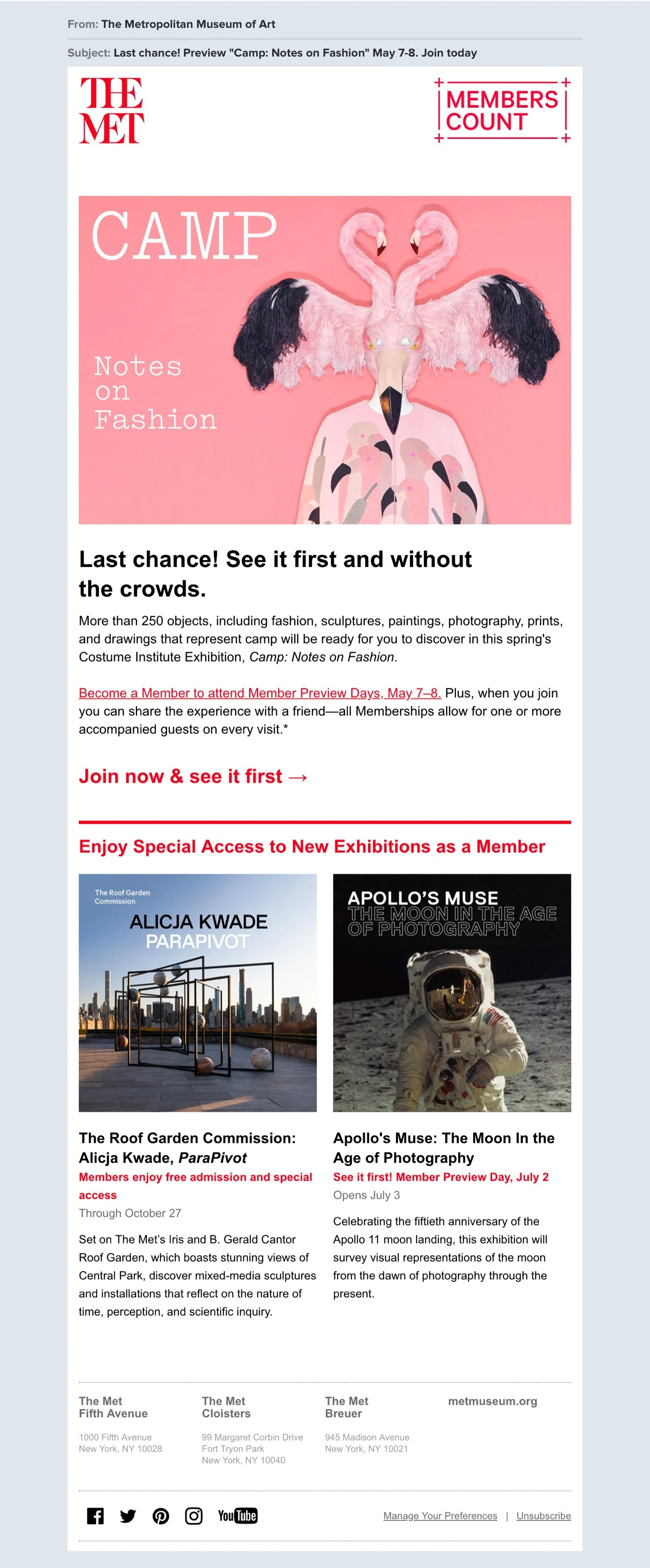
👉 Tip: If you regularly share updates on Facebook, Twitter or Instagram, you can embed this content into your newsletter to boost engagement.
2. Information about local events and art news
Give your readers the privilege of always being the first to know about openings, new collections or installations, local events, premium or limited edition prints, and more. This exclusive benefit also makes for a good call to action for people to sign up for your art newsletter.
In the examples below, you'll see how JUNIQE shares the latest art news.
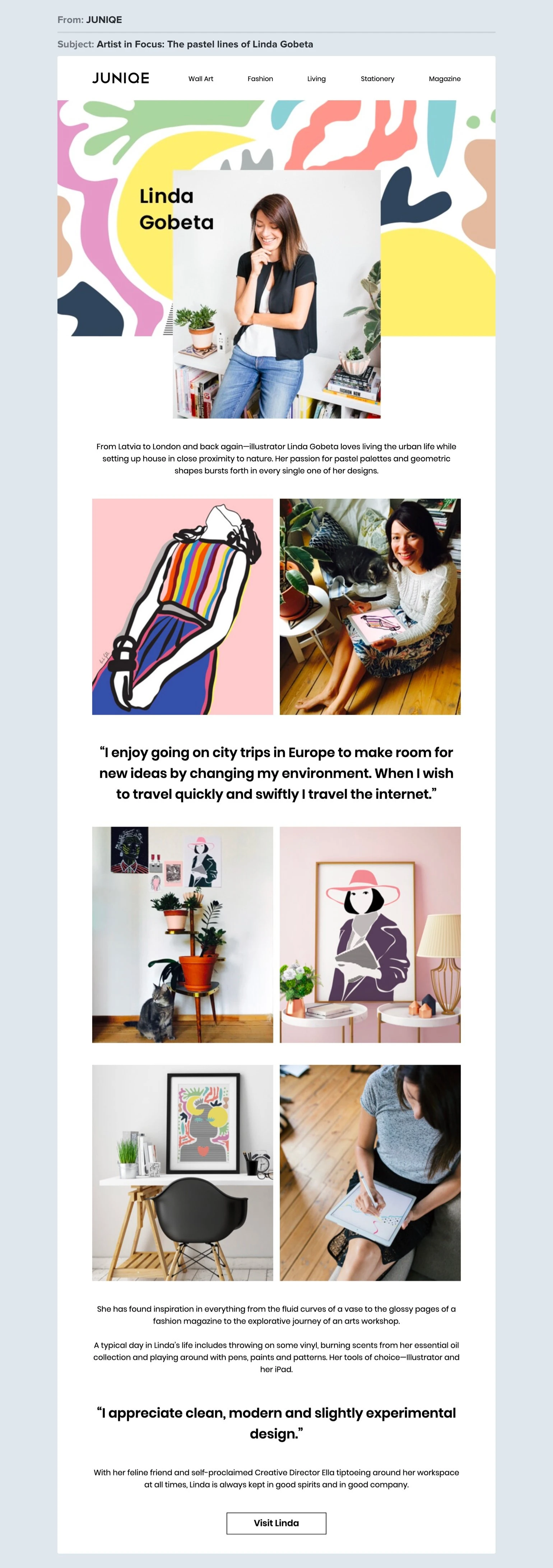
👉 Tip: Do you organize events, but are unsure how to promote them using email marketing campaigns? Our email marketing guide for event organizers tells you exactly how to attract visitors and make your event a great success!
3. Behind-the-scenes and work in progress
People love peeking into an artist’s process. Show people a sliver of what it’s like to live that creative life of yours! It piques people’s interest and is an easy way to get them primed for the new artwork you’re about to launch.
For galleries or museums, you could share stories about what’s happening inside your venue. This could be an exclusive behind-the-scenes photo essay of the team installing a new exhibit, a curator's personal notes on selecting pieces for an upcoming show, or the first photos of a new art series chosen for an event. You can also make it more interactive by adding videos.
4. A day in the studio
Invite your subscribers into your world by sharing what a day in the studio truly looks like. It helps build a personal connection with your fans and gives them a sneak peek at your creative process.
For example, you can share a series of candid photos or a short video montage. Include snapshots of your current project on the easel, your favorite tools laid out, a close-up of a new color palette you're experimenting with, or a shot of your coffee mug amidst your supplies.
Add short, engaging captions describing each moment, like "Starting the day with a fresh canvas and a clear mind," or "Late night details: Where the magic happens."
5. From the sketchbook
The sketchbook is often where ideas first take flight. Give your audience an exclusive peek into your initial concepts, preliminary drawings, or experimental studies. This raw, unfiltered view of your creative process can be incredibly engaging, showing the evolution of an idea before it becomes a finished piece.
Include high-quality scans or clear photos of a few sketchbook pages. You could showcase initial thumbnail sketches for a large painting, a character design evolving through multiple iterations, or abstract marks from a brainstorming session.
6. Creative influences
Share your creative influences with your subscribers. The artists, movements, books, music, or even everyday moments that spark your imagination and inform your work.
As a gallery, you can highlight the creative influences that shape the work of the artists you represent. This offers valuable context for the art while letting subscribers connect with the artistic vision on a deeper, more personal level.
Dedicate a newsletter segment titled "The artist's muse: Where does inspiration come from?" You could feature one of your represented artists and delve into their sources of inspiration.
7. The tools I use
Artists often have a fascinating array of materials and equipment. Share the tools you use in your practice—whether it's specific brands of paint, types of brushes, digital software, or studio furniture. This can be informative for aspiring artists, curious collectors, and anyone interested in the technical aspects of art creation.
In your email, feature a few key tools with high-quality photos. For example, your go-to watercolor set or the tablet or software you use to create digital art. Briefly explain why you prefer these tools and how they aid your creative process.
8. Advice and skills sharing
Why not reveal some tricks of the trade? We bet your readers would love to know about your techniques, what tools you use, and what best practices you follow.
Use your art newsletter to share your secrets or promote an upcoming workshop you organize, just like Dot Kids does below.

9. Some art history
Infuse your newsletters with educational value by including art history. Share facts about famous artists, historical art movements, or the cultural context behind some of your styles. This enriches your subscribers' understanding of art and positions you as a knowledgeable and passionate authority in the art world.
You could start a recurring segment in your email called "Art History Minute” or "Gallery insights: A moment in art history." You could also pose questions at the end to encourage thought, such as "How do you see these historical concepts reflected in contemporary art today?"
10. Ask me anything
Host an ask me anything (AMA) session, where subscribers can submit questions about your art, your process, your inspirations, or your life as an artist. You can answer these questions directly in a subsequent newsletter, through a short video, or even live on a social media platform like Instagram, then share the recording in your newsletter.
Promote the date and time in your newsletter and link-in-bio, promising to share the recording afterward. This is a fantastic way to build community and demystify the artistic process.
11. Vote for the next print (surveys)
Engage your audience directly via surveys by inviting them to vote for the next print or the next subject of a new artwork series using a simple survey. This interactive approach makes subscribers feel invested in your creative journey and gives them a voice, strengthening their connection to your brand.
Create an email titled "Help me choose! Vote for my next limited edition print." Present 2-3 high-quality images of potential new artworks or design concepts that you're considering for your next print run.
Include a clear call to action to a simple online survey tool (like Google Forms or your email platform's survey feature) where they can cast their vote. You could even offer a small discount to those who participate once the winning print is announced.
MailerLite lets you create professional surveys that you can embed right inside your emails. We have pre-built survey email templates for NPS, open-ended questions, multiple-choice questions, and more.
12. Subscriber-only "first look"
Offer your loyal fans a subscriber-only “first look" at new digital products, such as new print releases, digital art downloads, online course modules, or e-books. This creates a valuable incentive for people to stay subscribed and feel part of an inner circle. It also makes them more likely to buy your art.
Reward your dedicated subscribers with exclusive early access or a special discount on your upcoming products. For instance, share a direct, unlisted link to a private page on your website where they can preview or pre-order new digital prints before the general public. Emphasize that this access is a special thank you just for them.
Did you know that you can now sell digital products directly through MailerLite? Just connect your existing Stripe account and you’re done! You can add product blocks right into your newsletter, making it super easy for your readers to buy your stuff directly from your newsletter. And the cherry on top? We take 0% commission; only Stripe’s payment processing fees apply.
13. Sales, specials, and freebies
Once you’ve built a substantial relationship, you may go ahead and promote your work. You could start by giving away a freebie or offering a discount. Let your art shine with well-chosen imagery and create clear call-to-action buttons so people are drawn to click, thus raising your click rates.
We love the newsletters of our customer, Marc Johns. His tone of voice, high-quality images and modern layout make his newsletters a joy to receive.

Now that you have some idea about what kind of emails to send, check out our artist and gallery templates to inspire you further.
14. Bundle offer
Bundle offers are a brilliant way to add value for your customers and encourage sales. Create curated sets of complementary artworks or products, for example, a limited edition print paired with an art book, a series of smaller pieces, or a digital art pack.
Position these bundles as special deals that provide more value when purchased together. Clearly state the individual price versus the bundle price to highlight the savings, and either embed the digital product bundles in your MailerLite newsletter or include a direct link to purchase the bundle on your shop.
15. Gift guide
During holidays or special occasions, create a gift guide featuring your artwork. If you’re a gallery, you could include curated art books or exclusive exhibition merchandise within your gift guide.
Categorize your pieces by price point, recipient type, or theme to make shopping easier for your subscribers. This can be an effective way to take advantage of seasonal buying trends and present your art as thoughtful and unique presents. Include compelling images of each suggested gift and direct links to the product pages.
Check out our gift newsletter templates.
Best practices for your email newsletter
When you feel familiar enough with your newly learned craft, you can take it up a notch with these art newsletter best practices.
Segment your subscribers
This might sound complicated but segmentation simply means grouping subscribers that share similar traits. Why do you need to segment your subscribers? Because when you send targeted emails specific to segments, your average open and click-through rates (CTR) increase by 36.69% and 267.21% compared to non-targeted email campaigns.
You might choose to segment people who've bought your artwork and those who haven't. You can also segment people by their taste in art or what type of connection they are (prospect or journalist?). Once you’ve created these segments, you can send each group a tailored newsletter.
Setting up segments is straightforward in MailerLite. You can create groups based on various criteria, like subscriber activity (who opened your last email), custom fields (like "art preference" or "collector type"), or purchase history if integrated with your e-commerce platform. This lets you easily target your messages to the right people.
Automate your messages
One reason why email marketing is so efficient is that you don't actually have to send your emails manually every time. With automation, you can, for example, send a welcome email immediately after someone signs up to your list. Furthermore, you can schedule discount or promotion emails to go out at certain times of the year.
MailerLite's automation workflows make all this incredibly easy. You could send a multi-email welcome series introducing new sign-ups to your gallery or artistic journey, birthday greetings for loyal fans with a special offer, or follow-ups after an online purchase, providing care instructions for their new artwork. We also have integrations relevant to musicians, painters and photographers, and you can integrate with more tools via Zapier.
For example, artist Remon de Jong uses MailerLite’s WordPress integration to collect subscribers through his website via pop-ups and embedded forms. He also integrates his WooCommerce store in his email strategy thanks to MailerLite’s WooCommerce integration. This lets him do things like include product blocks within his emails to showcase his art and boost sales.
Use AI to your advantage
No, AI will never replace something as intrinsically human, vulnerable, and beautiful as art. But it can be a helpful assistant, freeing up your valuable time so you can focus on what you do best: creating, curating, and connecting.
For example, AI can quickly help you draft compelling copy for your newsletters. This means less time staring at a blank screen and more time pouring your energy into your craft. MailerLite’s built-in AI writing assistant and subject line generator are right there in the editor, ready to help you brainstorm and refine your message until it feels just right.
AI can also figure out the right time to send your email to each subscriber. This simple adjustment can make a big difference in how many people see and appreciate your work. MailerLite’s smart sending feature handles this automatically, taking the guesswork out of timing your campaigns.
And for understanding what truly resonates with your audience, AI can give great insights about your email performance. Instead of spending hours digging through reports, AI can quickly give you clear answers. For example, with MailerLite's Model Context Protocols (MCP) server, you can connect AI tools like ChatGPT or Claude directly to your account, and ask questions like:
What topics from my recent studio updates led to the most clicks on my artwork portfolio?
Which exhibition announcements over the last six months had the highest open rates, and what did they have in common?
What key emails did subscribers who bought a piece click and open before making the purchasing decision?
And that’s not all! The MCP can also help you with the day-to-day work of managing your email marketing. You could ask it to:
Create a new campaign: Draft a promotional email for my upcoming 'Spring Collection' of landscape paintings, with a catchy subject line and a clear call to action to pre-order
Manage your subscribers: Identify all my subscribers who have not opened an email in the last six months and create a new segment called 'Inactive Subscribers'
Build an automation: Create a simple automation that sends a welcome series of three emails to new subscribers, introducing my work and studio
Design a form: Help me draft the text for a new pop-up form on my website that offers a free digital print in exchange for an email address
This makes understanding your audience and managing your email marketing strategy incredibly easy and fast.
Plan your content
Planning your content in advance ensures consistency, helps you align newsletters with events or new releases, and keeps your messaging fresh and relevant. Even a basic content calendar can bring order and efficiency and save you a ton of time.
If you’re an artist, you could plan your newsletter topics around the completion dates of new artworks or upcoming online workshops. A gallery could plan its calendar around exhibition schedules, art fair participations, and seasonal themes (e.g., a holiday gift guide).
Download our free Email Content Calendar Template to get a headstart on planning!
A/B test your campaigns
A/B testing means sending two slightly different versions of an email to a small part of your list to see which one performs better. You could test different subject lines, calls-to-action, images, or even entire layouts. This helps you understand what truly grabs your audience's attention, leading to better engagement over time.
MailerLite makes this easy, allowing you to A/B test almost any element of your email, from subject lines to the content, to different images and sending times. This constant learning helps you fine-tune your strategy, boosting opens, clicks, and conversions, whether you're an artist looking to sell more prints or a gallery aiming for higher event RSVPs.
Personalize your messages
Go beyond just using a subscriber's first name. Personalization enables you to deliver content that feels specifically relevant to the individual based on their preferences, past interactions, or expressed interests. It makes your emails feel like a personal conversation, not a mass broadcast.
Use custom fields in MailerLite to store subscriber information and dynamically insert it into your emails, making each message unique. You can also use conditional content blocks to show different sections of an email to different segments, delivering highly personalized experiences.
Check your performance reports
Regularly looking at your performance reports—like who's opening your emails, what they're clicking on, and if anyone's unsubscribing—is incredibly important. These insights are your guide, showing you what content is resonating and what might need a tweak, helping you adjust your strategy for future emails.
With MailerLite, you get powerful campaign reports beyond just opens and clicks. For example, if you’re an artist selling prints or digital downloads, you can see exactly which emails led to purchases, generated revenue, and resulted in conversion rates.
For galleries or museums offering tickets or merchandise, you can track how your email campaigns translate into ticket sales, shop revenue, and online registrations.
This means you'll have a clear, granular view of your sales funnel, complete with detailed order information, allowing you to fine-tune your approach for the best possible return on your efforts.
Clean up your lists regularly
Maintaining a "clean list" means removing inactive or unengaged subscribers. This might seem counterintuitive, but it actually improves your email deliverability, boosts your engagement rates, and ensures your messages are reaching people who genuinely want to hear from you.
Periodically, you could send a re-engagement email to inactive subscribers. If they still don't open, it's a good sign to remove them. A gallery might focus on cleaning lists after major events, making sure only truly interested prospects remain.
MailerLite’s sister company, MailerCheck, is the perfect tool to help you verify and clean your email list. You get 200 credits to get started when you sign up for free.
Don’t spam, do build trust
Spamming isn't just about sending too many emails; it's about sending irrelevant or unwanted content. Always prioritize providing value and respecting your subscribers' inboxes. Your goal is to build a relationship of trust, where your emails are eagerly anticipated, not dreaded.
Only send emails when you have something genuinely interesting or valuable to share, whether it's a new artwork, an insightful story, an event invitation, or an exclusive offer. Avoid sending daily emails if your content doesn't warrant it.
Don’t buy email lists 🙂
Never purchase email lists. These lists are almost always outdated, contain a high percentage of invalid addresses, and are populated with people who have not opted in to receive communications from you. They might also contain spam traps, which are email addresses used to identify spammers.
Sending to purchased lists will damage your sender reputation, lead to high bounce and spam complaint rates, and is often illegal under data privacy regulations.
Building a genuine, engaged audience through organic sign-ups ensures that the people receiving your emails actually want to hear from you, leading to higher open rates, more clicks, and ultimately, better results for your art or gallery business.
The artist email newsletter checklist
Now that you’ve seen what newsletters other art galleries, museums, art schools and artists send, it’s up to you to take your tools and get artsy.
Remember the few things your newsletter should contain:
Attractive visuals
Visible call to action (like RSVP, redeem my discount or visit online art shop)
Contact information
Existing email address to reply to
Links to your website or social media platforms
If applicable: Address of your gallery or studio
If applicable: Opening hours
Use your available art content to design emails that your followers will read. Not sure how to go about doing this? We break it down into two main design elements in the following guide on how to design emails people will read.
It's time to start your art email campaign now
You now have the tools and inspiration to use email marketing to its full potential, building meaningful connections that lead to art sales. Don't let these ideas just sit there. The best time to start is now.
Start small by defining your scope, then send that first email. The journey of transforming your business with email starts with a single message.
You're now ready to bring out your artsy side and start your very first email newsletter!
Create your first art email campaign in minutes!
Our free plan includes intuitive drag & drop editors, web landing pages, email automation, and tools to easily manage your subscribers!
